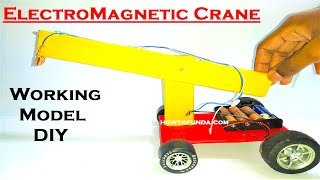In this post I have give 10+ science project ideas with magnet you can do it for your science exhibition

1)Electromagnetic crane working model project
An electromagnetic crane is a fascinating working model that demonstrates the principles of electromagnetism and its application in lifting heavy objects.
This model uses an electromagnet, which is a coil of wire with an electric current running through it, to create a strong magnetic field. When the current flows, it magnetizes the coil and attracts ferrous objects like iron or steel.
2) Magnetic science project working using paper cup and safety pins
Magnetic levitation is a captivating phenomenon that showcases the incredible power of magnets to suspend objects in the air. This technology has real-world applications, including high-speed trains and transportation systems.
Exploring magnetic levitation is not only visually stunning but also an educational opportunity to learn about magnetic forces and their potential uses in modern technology.
3) Magnetic science project working model for exhibition using pencil with round magnets
4) Magnet project for science project for newtons 3rd law
5) Magnetic science project for school science exhibition using chop sticks
6) Magnetic levitation working project
Magnetic levitation, often abbreviated as “Maglev,” is a revolutionary technology that allows objects to float and move without physical contact with any surface. It achieves this by utilizing the repulsive and attractive forces between magnets. When properly applied, magnetic levitation can lift objects off the ground, providing a unique and futuristic mode of transportation and a captivating scientific demonstration.
The main objective of exploring magnetic levitation is to understand and witness the remarkable interaction between magnets that enables objects to defy gravity.
This phenomenon has practical applications in fields like transportation, where frictionless and efficient movement is desired. Additionally, it serves as an engaging educational tool to illustrate magnetic principles.
7) Liquid magnet experiment
The primary objective of this experiment is to witness and understand how magnets affect the behavior of water, particularly when iron particles are present. We aim to observe the magnetic field lines around the magnets, as well as the motion and alignment of iron filings suspended in the water. Through this experiment, we can visualize the invisible forces of magnetism.
8) DC motor using magnet and coil for school science exhibition working model
The “DC Motor Using Magnet and Coil” is a simple yet ingenious project that allows us to witness the transformation of electrical energy into mechanical motion.
It operates on the principles of electromagnetism, where the interaction between a magnetic field and a current-carrying coil generates rotational movement.
In this project, we’ll construct a basic DC (Direct Current) motor using readily available materials to better understand the concepts behind electric motors.
The primary objective of this project is to build a functional DC motor that demonstrates the conversion of electrical energy into mechanical motion.
By constructing this model, we aim to explore the fundamental principles of electromagnetism, electromagnetic induction, and the operation of a basic electric motor.
9. Magnetic swing working model for school science project
The Magnetic Swing working model is a fascinating exploration of the interaction between magnets and ferrous (iron-containing) materials.
Instead of the conventional pendulum strings, this model uses magnetic repulsion and attraction to set the pendulum in motion.
When you bring magnets close to or move them away from the swing, it creates an intriguing dance of forces.
This project not only showcases the magic of magnetism but also demonstrates the principles of simple harmonic motion.
The primary objective of this project is to understand and demonstrate how magnets can be used to control the motion of a pendulum.
By creating a Magnetic Swing, we aim to explore the interplay of magnetic forces and how they influence the swing’s movement.
Additionally, this project provides insights into concepts like equilibrium, oscillation, and the relationship between potential and kinetic energy.

